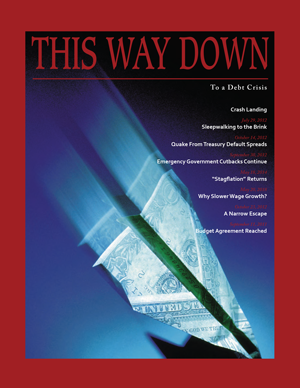This Way Down to a Debt Crisis

-
Publication Date:
January 25, 2011
What will happen if the United States continues to ignore the size and growth of the national debt? That is the question explored by a new CED report. This Way Down to a Debt Crisis is a “magazine from the future” that “reports” what might happen if the nation does not address the many dangers posed by rising national debt.
Listen to the release event featuring Dr. Joseph Minarik, Senior Vice President and Director of Research at CED; Dr. Alice M. Rivlin, former Director of the Office of Management and Budget, and Dr. Thomas E. Mann, Senior Fellow of Governance Studies, both of the Brookings Institution; and Dr. Norman Ornstein, Resident Scholar at the American Enterprise Institute.
About the Development of This Way Down
CED's Subcommittee decided early in its deliberations that the public urgently needs a clear statement of the consequences of inaction, to understand how much is at stake in the nation's budget crisis.
Creating such a statement proved not to be a simple task. For one thing, concerned economists and business persons - including Trustees of CED - have expressed concern about the U.S. budget deficit for some time. Many citizens have said openly that they have heard "wolf" cried for too long with no ill effects for the economy, and so they have come to conclude that "deficits don't matter." Also, the budget has strayed so far from even its extreme bounds of the last half century, and the global economy is itself so troubled, that the nation has truly "sailed off the charts" to the point where the effects of continued accumulation of debt are not easily predictable.
As a result, the work of our Subcommittee became quite complex. The first task was to explain why the nation's current course entails substantial risk, even though some aspects of the current situation - low interest rates and low inflation - would appear contrary to the expected ill effects of deficits. (Of course, the current sluggish economic growth and high unemployment are most worrisome, but those too are not conditions usually thought to arise from the early stages of large government budget deficits.) The second task was to provide some vision of the likely consequences of continued runaway debt accumulation, even though economic circumstances are so extraordinary that no one particular outcome is certain to arise.
The Subcommittee chose to explain several of these "alternative futures" as they might occur, through possible news articles of the future. Although these articles are of course fictitious, and include fictitious characters to illustrate the human consequences, they are based on sound economic and financial principles. Because the future is unknowable, it is by no means certain that any one of these scenarios will occur precisely as described. In fact, the future is highly likely to surprise us in many respects. However, the Subcommittee believes that the presented scenarios reflect well the seriousness of the outcomes of continued policy failure in the stewardship of the federal budget.
The Subcommittee started by extrapolating the current pattern of behavior in Washington. It described the consequences if our elected policymakers continue to follow a course that is politically - though certainly not economically or financially - risk averse: refusing to raise taxes, and refusing to consider spending savings in Social Security, Medicare, and defense. The Subcommittee reasonably concluded that financial markets that always had assumed that the United States eventually would face reality could conclude otherwise when both political parties approach an election for a four-year presidential term by ruling out all necessary and sufficient remedies for the budget problem.
-
Complimentary.








